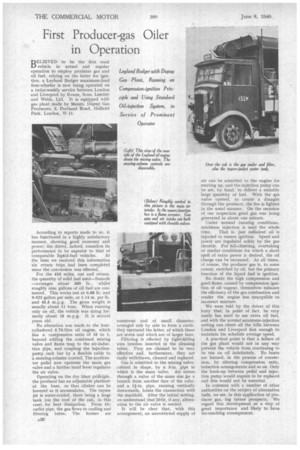First Producer-gas Oiler in Operation
Page 28

If you've noticed an error in this article please click here to report it so we can fix it.
Leyland Badger with Dapiry Gas Plant, Running on Compression-ignition Prin iple Using Standard Oil-injection System, in Service of Prominent Operator BELIEVED to be the first road vehicle in actual and regular operation to employ producer gas and oil fuel, relying on the latter for ignition, a Leyland Badger maximum-load four-wheeler is now being operated on a twice-weekly service between London and Liverpool by Evans, Sons, Lescher and Webb, Ltd. It is equipped with gas plant made by Messrs. Dupny Gas Producers, 2, Portland Road, Holland Park London, W.11.
According to reports made to us, it has functioned in a highly satisfactory manner, showing good economy and power; the driver, indeed, considers its performance to be superior to that of comparable liquid-fuel vehicles. At the time we received this information six return trips had been completed since the conversion was effected.
For .the 410 miles, out and return, the quantity of solid fuel used—Suncole —averages about 360 lb., whilst roughly nine gallons of oil fuel are consumed. This works out at 0.88 lb. and 0.022 gallon per mile, or 1.14 m. per lb. and 45.5 m.p.g. The gross weight is usually about 11 tons. When running only on oil, the vehicle was doing formerly about 15 m.p.g. It is several years old.
No alteration was made to the fourcylindered 5.73-litre oil engine, which has a compression ratio of 15 to 1, beyond adding the ,combined mixing valve and flame trap to the air-induction pipe, and coupling the injectionpump rack bar by a flexible cable to a steering-column control. The accelerator pedal now operates the main gas valve and a further hand lever regulates the air valve.
Operating on the dry blast priliciple, the producer has an adjustable platform at the base, so that clinker can be lowered as it accumulates. The tuyere jet is water-cooled, there being a large tank (on the roof of the cab,. in this case) for heat dissipation. From th.-: outlet pipe, the gas flows to cooling and filtering tubes. The former are
numerous and of small diameter; arranged side by side to form a circle. they surround the latter, of which there are seven and which are of larger bore.
Filtering is effected by tight-fitting wire brushes inserted in the cleaning tubes. They are claimed to be very effective and, furthermore, they are easily withdrawn, cleaned and replaced.
Gas is admitted to the mixing valve, cubical in shape. by a 3-in, pipe in which is the main valve. Air enters through a valve of the same size by a branch from another face of the cube, and a It-in. pipe, running vertically downwards, forms the connection with the manifold. After the initial setting, we understand that little, if any, alteraation to the air valve is needed.
It will be clear that, with this arrangement, an unrestricted supply of air can be admitted to the engine for starting up, and the injection pump can be set, by hand, to deliver a suitably large quantity of fuel. With the gas valve opened, to create a draught through'the producer, the fire is lighted in the usual manner. On the occasion of our inspection good gas was being generated in about one minute.
Under normal running conditions, minimum injection is used the whole time. That is, just sufficient oil is injected to ensure ignition. Speed and power are regulated solely by the gas throttle. For hill-climbing, overtaking or similar conditions for which a short spell of extra power is desired, the oil charge can he increased. At all times, of course, the producer gas is, to some extent, enriched by oil, but the primary function of the .liquid fuel is ignition.
No doubt the high compression and good flame, caused by compression ignition of oil vappur, themselves enhance the efficiency of the gas combustion and render the engine less susceptible to incorrect mixture.
We were told by the driver of this lorry that, in point of fact, he very rarely has need to use extra oil fuel, and with the normal minimum-injection setting can climb all the hills between London and Liverpool fast enough to maintain his schedule average speed.
A practical point is that a failure of the gas plant would not in any way prevent the vehicle from continuing to be run on oil indefinitely. No boats are burned, in the process of conversion, by altering compression ratio, induction arrangements and so on. Only the hook-up between pedal and injection pump would require to be replaced and this would not be essential.
In common with a number of other authorities on the subject of alternative fuels, we see, in this application of producer gas, big future prospects. We regard this development as a step of great importance and likely to have far-reaching consequences.




















































